Sustainable Tourism Plan: Design and Implementation for Hotels
VerifiedAdded on 2022/09/16
|8
|1890
|31
Report
AI Summary
This report details a sustainable tourism plan designed for hotels, emphasizing the integration of environmentally conscious practices across various operational aspects. The plan begins with a focus on hotel design, advocating for the use of renewable energy sources such as solar power and implementing water conservation measures like recycling plants within guest rooms. It then extends to guest services, promoting the use of eco-friendly cleaning products, spa treatments with local and organic products, and linen reuse programs. The plan also addresses food and beverage services, encouraging the serving of local, organic food and providing alternatives to bottled water. Finally, it emphasizes responsible procurement practices, taking into account ethical sourcing, environmental impact, and life-cycle costing to minimize the carbon footprint and ensure a sustainable supply chain. The report references various academic sources to support its recommendations.
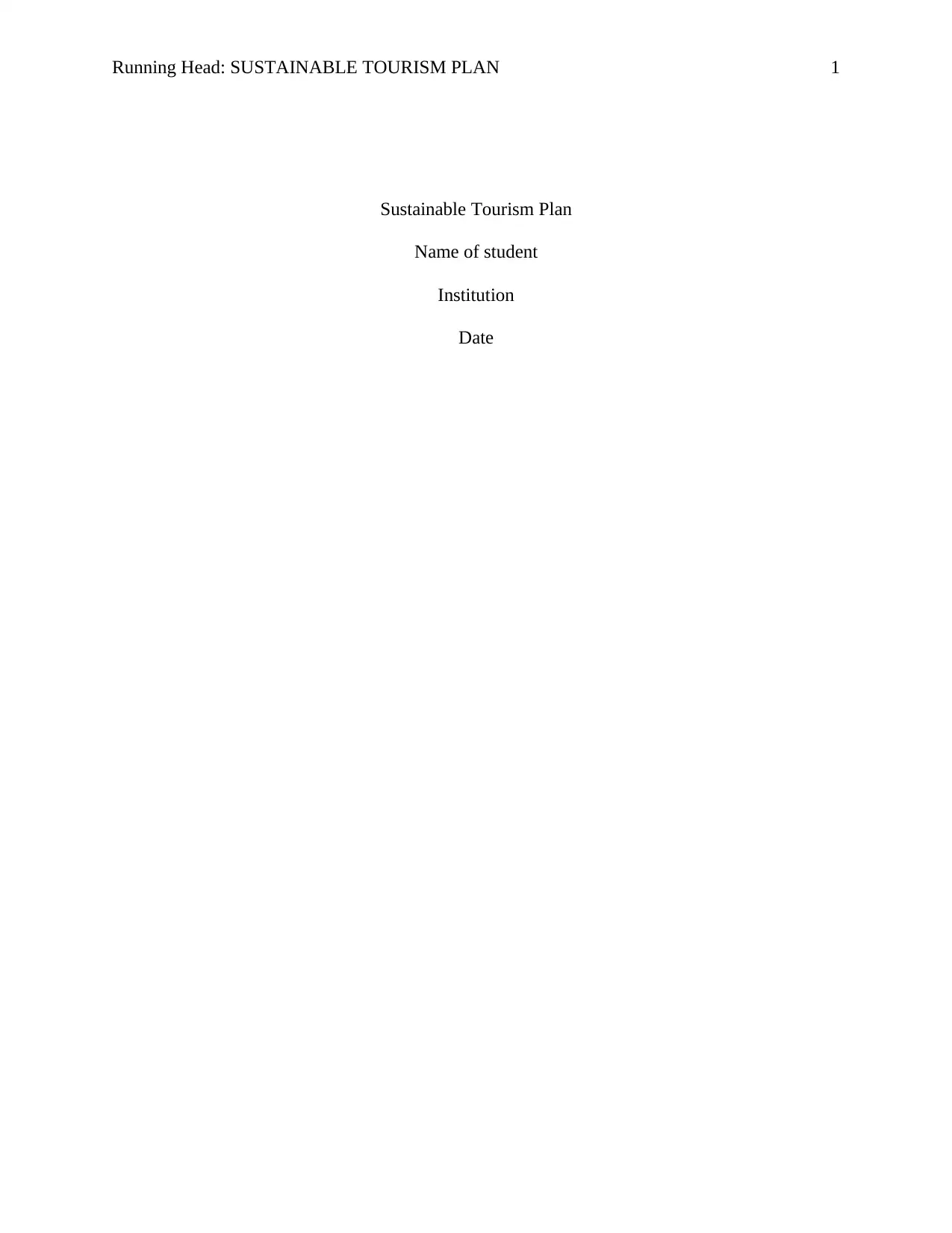
Running Head: SUSTAINABLE TOURISM PLAN 1
Sustainable Tourism Plan
Name of student
Institution
Date
Sustainable Tourism Plan
Name of student
Institution
Date
Paraphrase This Document
Need a fresh take? Get an instant paraphrase of this document with our AI Paraphraser
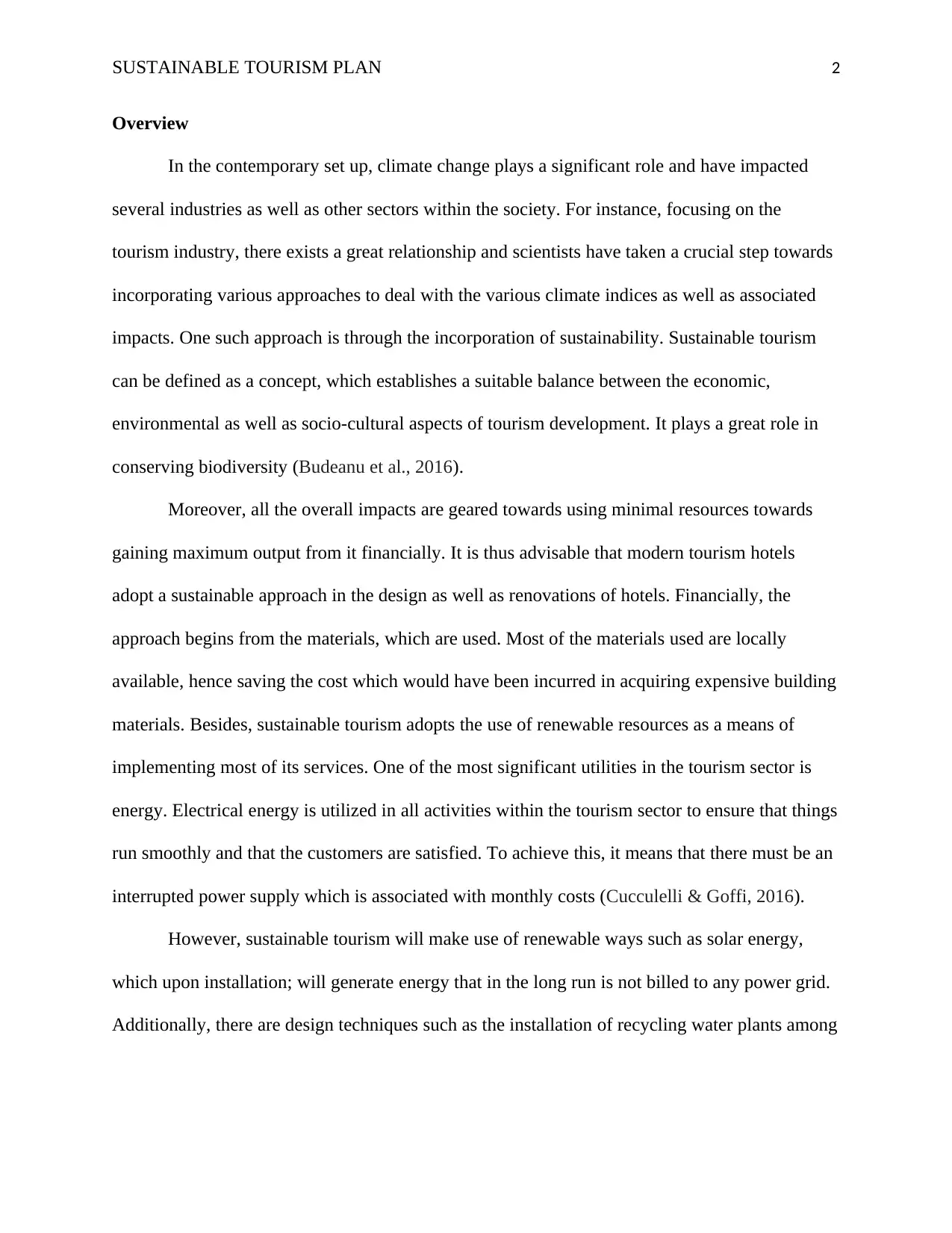
SUSTAINABLE TOURISM PLAN 2
Overview
In the contemporary set up, climate change plays a significant role and have impacted
several industries as well as other sectors within the society. For instance, focusing on the
tourism industry, there exists a great relationship and scientists have taken a crucial step towards
incorporating various approaches to deal with the various climate indices as well as associated
impacts. One such approach is through the incorporation of sustainability. Sustainable tourism
can be defined as a concept, which establishes a suitable balance between the economic,
environmental as well as socio-cultural aspects of tourism development. It plays a great role in
conserving biodiversity (Budeanu et al., 2016).
Moreover, all the overall impacts are geared towards using minimal resources towards
gaining maximum output from it financially. It is thus advisable that modern tourism hotels
adopt a sustainable approach in the design as well as renovations of hotels. Financially, the
approach begins from the materials, which are used. Most of the materials used are locally
available, hence saving the cost which would have been incurred in acquiring expensive building
materials. Besides, sustainable tourism adopts the use of renewable resources as a means of
implementing most of its services. One of the most significant utilities in the tourism sector is
energy. Electrical energy is utilized in all activities within the tourism sector to ensure that things
run smoothly and that the customers are satisfied. To achieve this, it means that there must be an
interrupted power supply which is associated with monthly costs (Cucculelli & Goffi, 2016).
However, sustainable tourism will make use of renewable ways such as solar energy,
which upon installation; will generate energy that in the long run is not billed to any power grid.
Additionally, there are design techniques such as the installation of recycling water plants among
Overview
In the contemporary set up, climate change plays a significant role and have impacted
several industries as well as other sectors within the society. For instance, focusing on the
tourism industry, there exists a great relationship and scientists have taken a crucial step towards
incorporating various approaches to deal with the various climate indices as well as associated
impacts. One such approach is through the incorporation of sustainability. Sustainable tourism
can be defined as a concept, which establishes a suitable balance between the economic,
environmental as well as socio-cultural aspects of tourism development. It plays a great role in
conserving biodiversity (Budeanu et al., 2016).
Moreover, all the overall impacts are geared towards using minimal resources towards
gaining maximum output from it financially. It is thus advisable that modern tourism hotels
adopt a sustainable approach in the design as well as renovations of hotels. Financially, the
approach begins from the materials, which are used. Most of the materials used are locally
available, hence saving the cost which would have been incurred in acquiring expensive building
materials. Besides, sustainable tourism adopts the use of renewable resources as a means of
implementing most of its services. One of the most significant utilities in the tourism sector is
energy. Electrical energy is utilized in all activities within the tourism sector to ensure that things
run smoothly and that the customers are satisfied. To achieve this, it means that there must be an
interrupted power supply which is associated with monthly costs (Cucculelli & Goffi, 2016).
However, sustainable tourism will make use of renewable ways such as solar energy,
which upon installation; will generate energy that in the long run is not billed to any power grid.
Additionally, there are design techniques such as the installation of recycling water plants among
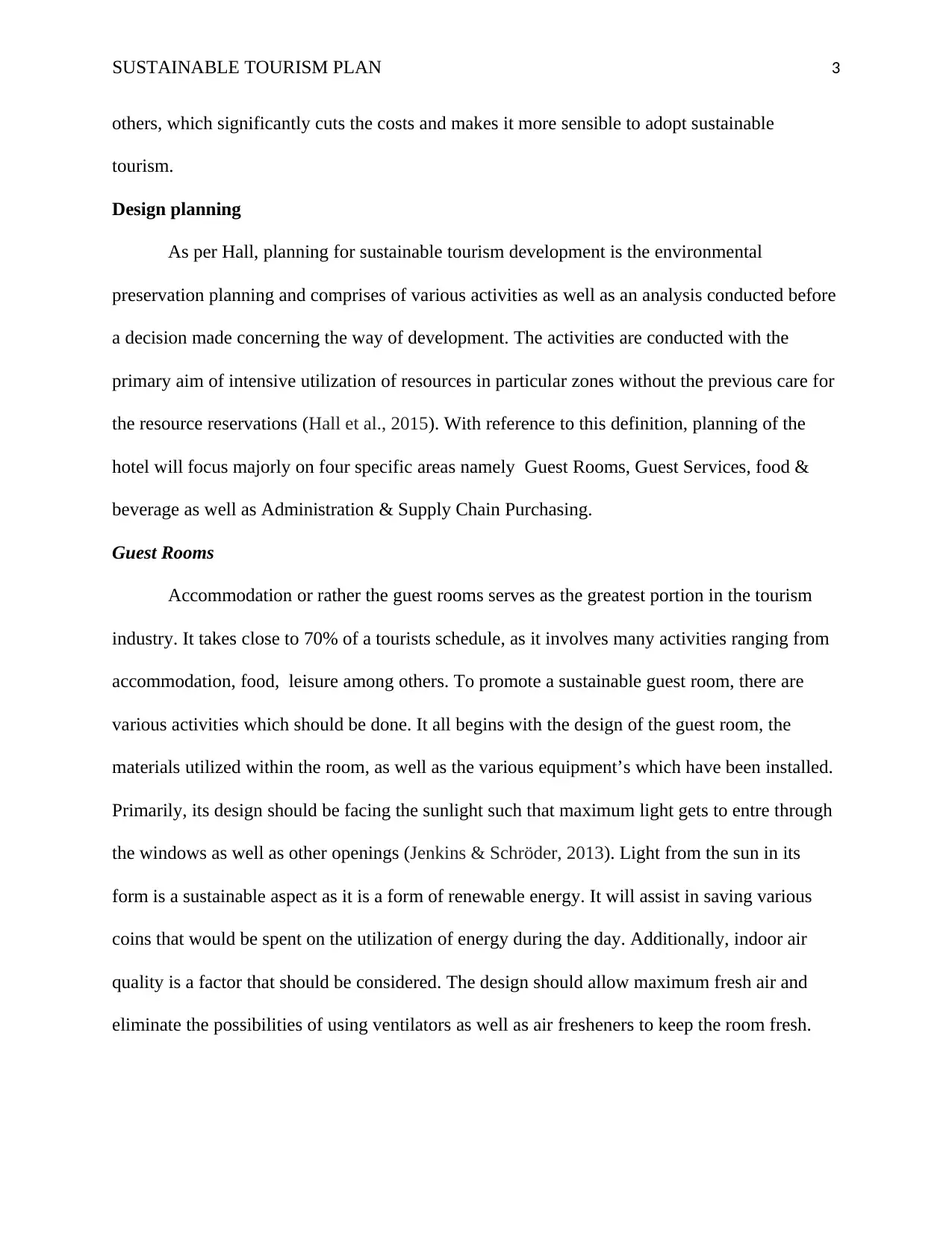
SUSTAINABLE TOURISM PLAN 3
others, which significantly cuts the costs and makes it more sensible to adopt sustainable
tourism.
Design planning
As per Hall, planning for sustainable tourism development is the environmental
preservation planning and comprises of various activities as well as an analysis conducted before
a decision made concerning the way of development. The activities are conducted with the
primary aim of intensive utilization of resources in particular zones without the previous care for
the resource reservations (Hall et al., 2015). With reference to this definition, planning of the
hotel will focus majorly on four specific areas namely Guest Rooms, Guest Services, food &
beverage as well as Administration & Supply Chain Purchasing.
Guest Rooms
Accommodation or rather the guest rooms serves as the greatest portion in the tourism
industry. It takes close to 70% of a tourists schedule, as it involves many activities ranging from
accommodation, food, leisure among others. To promote a sustainable guest room, there are
various activities which should be done. It all begins with the design of the guest room, the
materials utilized within the room, as well as the various equipment’s which have been installed.
Primarily, its design should be facing the sunlight such that maximum light gets to entre through
the windows as well as other openings (Jenkins & Schröder, 2013). Light from the sun in its
form is a sustainable aspect as it is a form of renewable energy. It will assist in saving various
coins that would be spent on the utilization of energy during the day. Additionally, indoor air
quality is a factor that should be considered. The design should allow maximum fresh air and
eliminate the possibilities of using ventilators as well as air fresheners to keep the room fresh.
others, which significantly cuts the costs and makes it more sensible to adopt sustainable
tourism.
Design planning
As per Hall, planning for sustainable tourism development is the environmental
preservation planning and comprises of various activities as well as an analysis conducted before
a decision made concerning the way of development. The activities are conducted with the
primary aim of intensive utilization of resources in particular zones without the previous care for
the resource reservations (Hall et al., 2015). With reference to this definition, planning of the
hotel will focus majorly on four specific areas namely Guest Rooms, Guest Services, food &
beverage as well as Administration & Supply Chain Purchasing.
Guest Rooms
Accommodation or rather the guest rooms serves as the greatest portion in the tourism
industry. It takes close to 70% of a tourists schedule, as it involves many activities ranging from
accommodation, food, leisure among others. To promote a sustainable guest room, there are
various activities which should be done. It all begins with the design of the guest room, the
materials utilized within the room, as well as the various equipment’s which have been installed.
Primarily, its design should be facing the sunlight such that maximum light gets to entre through
the windows as well as other openings (Jenkins & Schröder, 2013). Light from the sun in its
form is a sustainable aspect as it is a form of renewable energy. It will assist in saving various
coins that would be spent on the utilization of energy during the day. Additionally, indoor air
quality is a factor that should be considered. The design should allow maximum fresh air and
eliminate the possibilities of using ventilators as well as air fresheners to keep the room fresh.
⊘ This is a preview!⊘
Do you want full access?
Subscribe today to unlock all pages.

Trusted by 1+ million students worldwide

SUSTAINABLE TOURISM PLAN 4
Fresh circulation of natural air as well promotes the well being of the occupants (Kasim et al.,
2014).
There is also the aspect of renewable energy. Most hotels are working towards reducing
the amount of energy which is used within the hotel facility. Many activities consume a lot of
heat, for instance, the hot water systems, lighting systems, boilers, automated energy
management systems, among others. Incorporating renewable sources of energy such as solar
systems helps in cutting the cots which are incurred when meeting the energy demands from the
feed-in-tariffs. Solar power systems when designed and oriented effectively, has a greater
potential of capturing sunlight that in turn produce energy which can offer a great deal to the
hotel (Korez-Vide, 2013).
Water conservation measures also play a significant role. The guest rooms utilize a large
amount of water in performing various activities, and hence this water goes into waste as
wastewater. However, this water can be recycled back and used within the same system as either
yellow or black water. For instance; recycling plant can be established and the water is recycled
to be used in watering gardens, in flushing of the washrooms as well used in laundry systems.
Several wastes are also produced from the accommodation rooms, ranging from beverage
containers, newspapers, disposables, food waste among others. These products can be recycled
through food waste composting programs as well as renewable technologies, to be re-used once
more. Research demonstrates that hotels with capabilities of recycling wastes and food products
can upwardly demonstrate 50% of the total wastes diverted from landfills (Melissen et al., 2016).
The bath amenities as well can be made of custom-formulated amenities. The amenities
can be made such that they are all-natural, and essentially oil-based made without the addition of
preservatives as well as artificial ingredients. The guest room keys as well are made from
Fresh circulation of natural air as well promotes the well being of the occupants (Kasim et al.,
2014).
There is also the aspect of renewable energy. Most hotels are working towards reducing
the amount of energy which is used within the hotel facility. Many activities consume a lot of
heat, for instance, the hot water systems, lighting systems, boilers, automated energy
management systems, among others. Incorporating renewable sources of energy such as solar
systems helps in cutting the cots which are incurred when meeting the energy demands from the
feed-in-tariffs. Solar power systems when designed and oriented effectively, has a greater
potential of capturing sunlight that in turn produce energy which can offer a great deal to the
hotel (Korez-Vide, 2013).
Water conservation measures also play a significant role. The guest rooms utilize a large
amount of water in performing various activities, and hence this water goes into waste as
wastewater. However, this water can be recycled back and used within the same system as either
yellow or black water. For instance; recycling plant can be established and the water is recycled
to be used in watering gardens, in flushing of the washrooms as well used in laundry systems.
Several wastes are also produced from the accommodation rooms, ranging from beverage
containers, newspapers, disposables, food waste among others. These products can be recycled
through food waste composting programs as well as renewable technologies, to be re-used once
more. Research demonstrates that hotels with capabilities of recycling wastes and food products
can upwardly demonstrate 50% of the total wastes diverted from landfills (Melissen et al., 2016).
The bath amenities as well can be made of custom-formulated amenities. The amenities
can be made such that they are all-natural, and essentially oil-based made without the addition of
preservatives as well as artificial ingredients. The guest room keys as well are made from
Paraphrase This Document
Need a fresh take? Get an instant paraphrase of this document with our AI Paraphraser
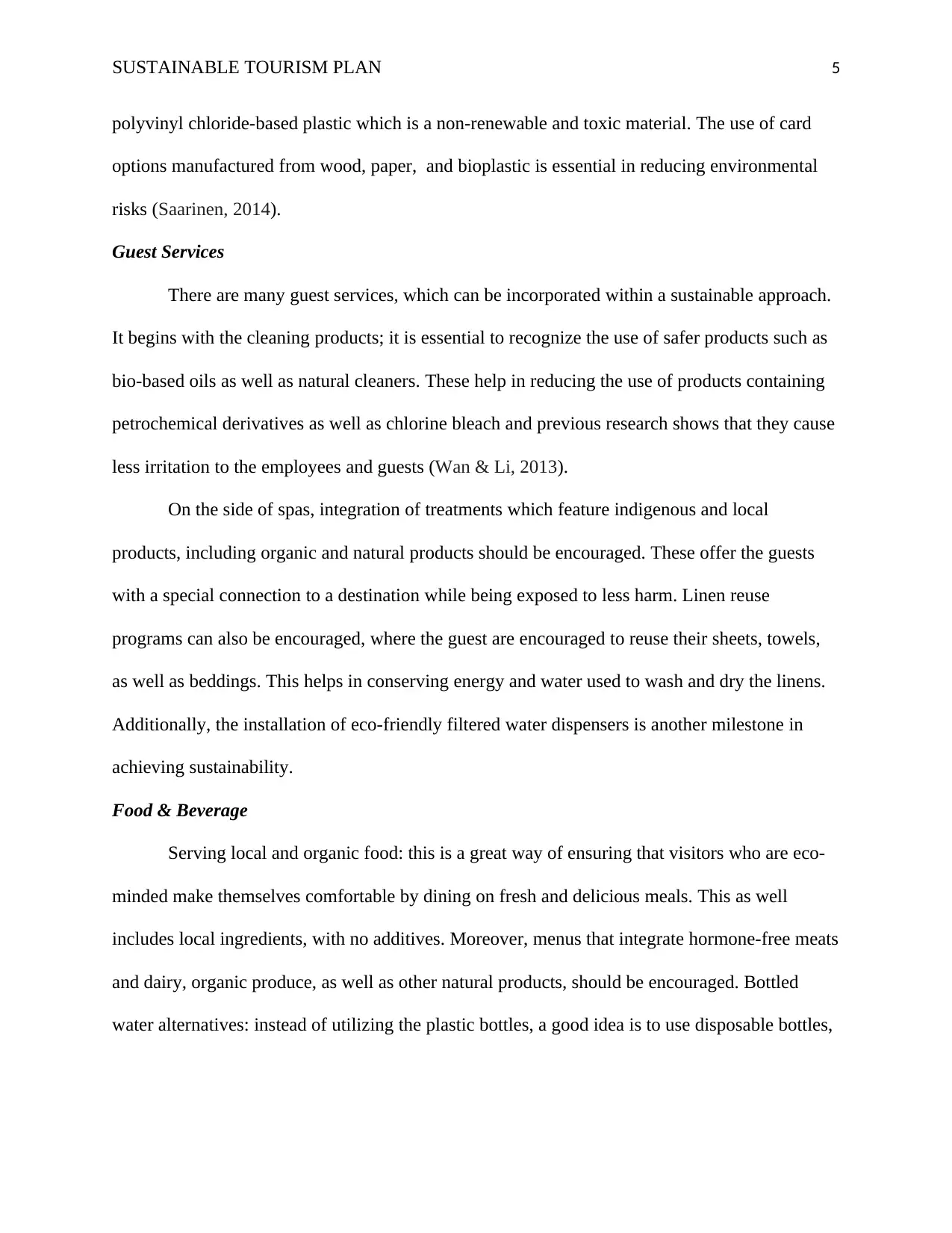
SUSTAINABLE TOURISM PLAN 5
polyvinyl chloride-based plastic which is a non-renewable and toxic material. The use of card
options manufactured from wood, paper, and bioplastic is essential in reducing environmental
risks (Saarinen, 2014).
Guest Services
There are many guest services, which can be incorporated within a sustainable approach.
It begins with the cleaning products; it is essential to recognize the use of safer products such as
bio-based oils as well as natural cleaners. These help in reducing the use of products containing
petrochemical derivatives as well as chlorine bleach and previous research shows that they cause
less irritation to the employees and guests (Wan & Li, 2013).
On the side of spas, integration of treatments which feature indigenous and local
products, including organic and natural products should be encouraged. These offer the guests
with a special connection to a destination while being exposed to less harm. Linen reuse
programs can also be encouraged, where the guest are encouraged to reuse their sheets, towels,
as well as beddings. This helps in conserving energy and water used to wash and dry the linens.
Additionally, the installation of eco-friendly filtered water dispensers is another milestone in
achieving sustainability.
Food & Beverage
Serving local and organic food: this is a great way of ensuring that visitors who are eco-
minded make themselves comfortable by dining on fresh and delicious meals. This as well
includes local ingredients, with no additives. Moreover, menus that integrate hormone-free meats
and dairy, organic produce, as well as other natural products, should be encouraged. Bottled
water alternatives: instead of utilizing the plastic bottles, a good idea is to use disposable bottles,
polyvinyl chloride-based plastic which is a non-renewable and toxic material. The use of card
options manufactured from wood, paper, and bioplastic is essential in reducing environmental
risks (Saarinen, 2014).
Guest Services
There are many guest services, which can be incorporated within a sustainable approach.
It begins with the cleaning products; it is essential to recognize the use of safer products such as
bio-based oils as well as natural cleaners. These help in reducing the use of products containing
petrochemical derivatives as well as chlorine bleach and previous research shows that they cause
less irritation to the employees and guests (Wan & Li, 2013).
On the side of spas, integration of treatments which feature indigenous and local
products, including organic and natural products should be encouraged. These offer the guests
with a special connection to a destination while being exposed to less harm. Linen reuse
programs can also be encouraged, where the guest are encouraged to reuse their sheets, towels,
as well as beddings. This helps in conserving energy and water used to wash and dry the linens.
Additionally, the installation of eco-friendly filtered water dispensers is another milestone in
achieving sustainability.
Food & Beverage
Serving local and organic food: this is a great way of ensuring that visitors who are eco-
minded make themselves comfortable by dining on fresh and delicious meals. This as well
includes local ingredients, with no additives. Moreover, menus that integrate hormone-free meats
and dairy, organic produce, as well as other natural products, should be encouraged. Bottled
water alternatives: instead of utilizing the plastic bottles, a good idea is to use disposable bottles,
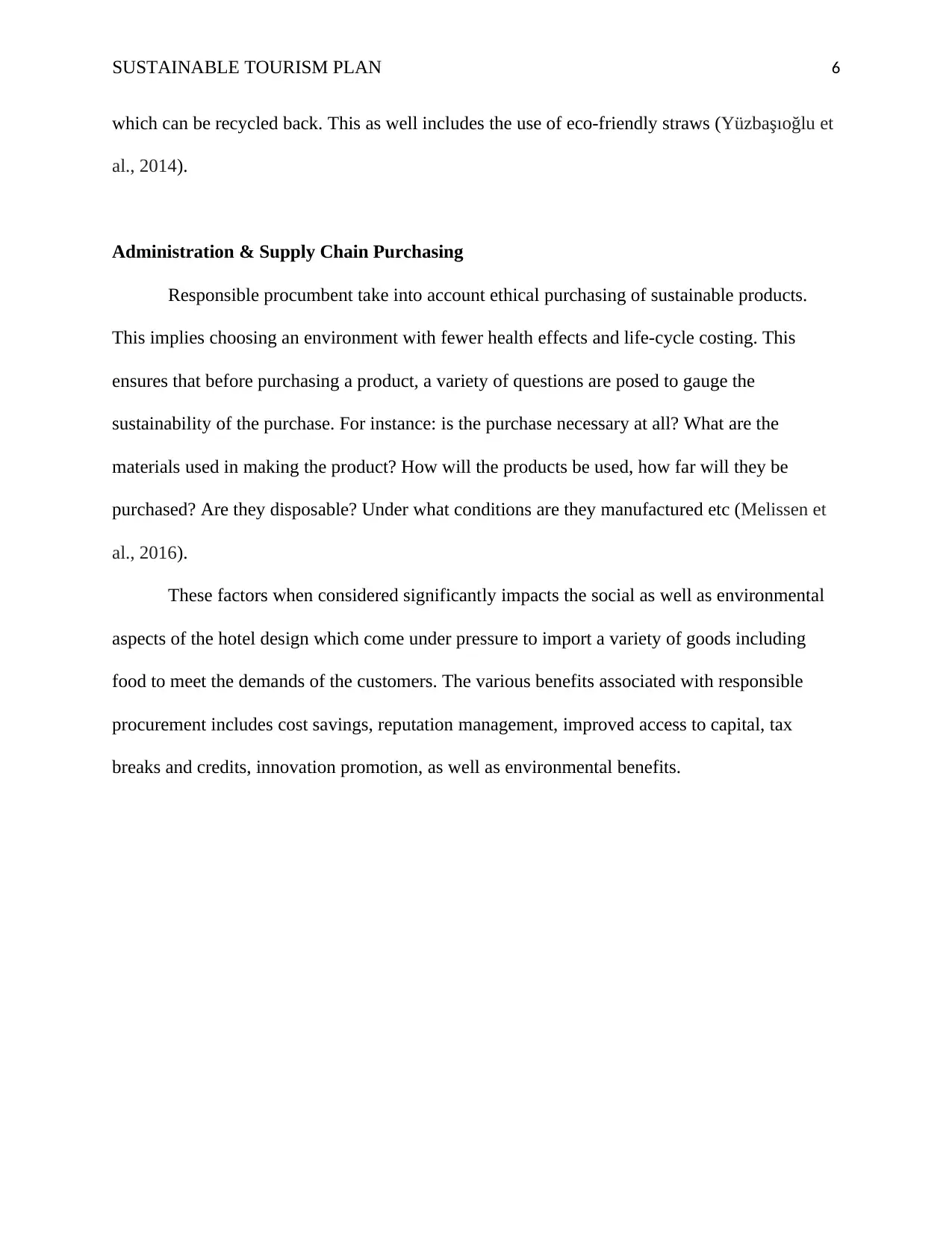
SUSTAINABLE TOURISM PLAN 6
which can be recycled back. This as well includes the use of eco-friendly straws (Yüzbaşıoğlu et
al., 2014).
Administration & Supply Chain Purchasing
Responsible procumbent take into account ethical purchasing of sustainable products.
This implies choosing an environment with fewer health effects and life-cycle costing. This
ensures that before purchasing a product, a variety of questions are posed to gauge the
sustainability of the purchase. For instance: is the purchase necessary at all? What are the
materials used in making the product? How will the products be used, how far will they be
purchased? Are they disposable? Under what conditions are they manufactured etc (Melissen et
al., 2016).
These factors when considered significantly impacts the social as well as environmental
aspects of the hotel design which come under pressure to import a variety of goods including
food to meet the demands of the customers. The various benefits associated with responsible
procurement includes cost savings, reputation management, improved access to capital, tax
breaks and credits, innovation promotion, as well as environmental benefits.
which can be recycled back. This as well includes the use of eco-friendly straws (Yüzbaşıoğlu et
al., 2014).
Administration & Supply Chain Purchasing
Responsible procumbent take into account ethical purchasing of sustainable products.
This implies choosing an environment with fewer health effects and life-cycle costing. This
ensures that before purchasing a product, a variety of questions are posed to gauge the
sustainability of the purchase. For instance: is the purchase necessary at all? What are the
materials used in making the product? How will the products be used, how far will they be
purchased? Are they disposable? Under what conditions are they manufactured etc (Melissen et
al., 2016).
These factors when considered significantly impacts the social as well as environmental
aspects of the hotel design which come under pressure to import a variety of goods including
food to meet the demands of the customers. The various benefits associated with responsible
procurement includes cost savings, reputation management, improved access to capital, tax
breaks and credits, innovation promotion, as well as environmental benefits.
⊘ This is a preview!⊘
Do you want full access?
Subscribe today to unlock all pages.

Trusted by 1+ million students worldwide

SUSTAINABLE TOURISM PLAN 7
References
Budeanu, A., Miller, G., Moscardo, G., & Ooi, C. S. (2016). Sustainable tourism, progress,
challenges and opportunities: an introduction.
Cucculelli, M., & Goffi, G. (2016). Does sustainability enhance tourism destination
competitiveness? Evidence from Italian Destinations of Excellence. Journal of Cleaner
Production, 111, 370-382.
Hall, C. M., Gossling, S., & Scott, D. (Eds.). (2015). The Routledge handbook of tourism and
sustainability. Routledge.
Jenkins, I., & Schröder, R. (Eds.). (2013). Sustainability in tourism: A multidisciplinary
approach. Springer Science & Business Media.
Kasim, A., Gursoy, D., Okumus, F., & Wong, A. (2014). The importance of water management
in hotels: a framework for sustainability through innovation. Journal of Sustainable
Tourism, 22(7), 1090-1107.
Korez-Vide, R. (2013). Promoting sustainability of tourism by creative tourism development:
how far is Slovenia?. Innovative issues and approaches in social sciences, 6(1), 77-102.
Melissen, F., van Ginneken, R., & Wood, R. C. (2016). Sustainability challenges and
opportunities arising from the owner-operator split in hotels. International Journal of
Hospitality Management, 54, 35-42.
Saarinen, J. (2014). Critical sustainability: Setting the limits to growth and responsibility in
tourism. Sustainability, 6(1), 1-17.
Wan, Y. K. P., & Li, X. (2013). Sustainability of tourism development in Macao,
China. International Journal of Tourism Research, 15(1), 52-65.
References
Budeanu, A., Miller, G., Moscardo, G., & Ooi, C. S. (2016). Sustainable tourism, progress,
challenges and opportunities: an introduction.
Cucculelli, M., & Goffi, G. (2016). Does sustainability enhance tourism destination
competitiveness? Evidence from Italian Destinations of Excellence. Journal of Cleaner
Production, 111, 370-382.
Hall, C. M., Gossling, S., & Scott, D. (Eds.). (2015). The Routledge handbook of tourism and
sustainability. Routledge.
Jenkins, I., & Schröder, R. (Eds.). (2013). Sustainability in tourism: A multidisciplinary
approach. Springer Science & Business Media.
Kasim, A., Gursoy, D., Okumus, F., & Wong, A. (2014). The importance of water management
in hotels: a framework for sustainability through innovation. Journal of Sustainable
Tourism, 22(7), 1090-1107.
Korez-Vide, R. (2013). Promoting sustainability of tourism by creative tourism development:
how far is Slovenia?. Innovative issues and approaches in social sciences, 6(1), 77-102.
Melissen, F., van Ginneken, R., & Wood, R. C. (2016). Sustainability challenges and
opportunities arising from the owner-operator split in hotels. International Journal of
Hospitality Management, 54, 35-42.
Saarinen, J. (2014). Critical sustainability: Setting the limits to growth and responsibility in
tourism. Sustainability, 6(1), 1-17.
Wan, Y. K. P., & Li, X. (2013). Sustainability of tourism development in Macao,
China. International Journal of Tourism Research, 15(1), 52-65.
Paraphrase This Document
Need a fresh take? Get an instant paraphrase of this document with our AI Paraphraser

SUSTAINABLE TOURISM PLAN 8
Yüzbaşıoğlu, N., Topsakal, Y., & Çelik, P. (2014). Roles of tourism enterprises on destination
sustainability: Case of Antalya, Turkey. Procedia-Social and Behavioral Sciences, 150,
968-976.
Yüzbaşıoğlu, N., Topsakal, Y., & Çelik, P. (2014). Roles of tourism enterprises on destination
sustainability: Case of Antalya, Turkey. Procedia-Social and Behavioral Sciences, 150,
968-976.
1 out of 8
Related Documents
Your All-in-One AI-Powered Toolkit for Academic Success.
+13062052269
info@desklib.com
Available 24*7 on WhatsApp / Email
![[object Object]](/_next/static/media/star-bottom.7253800d.svg)
Unlock your academic potential
Copyright © 2020–2025 A2Z Services. All Rights Reserved. Developed and managed by ZUCOL.





